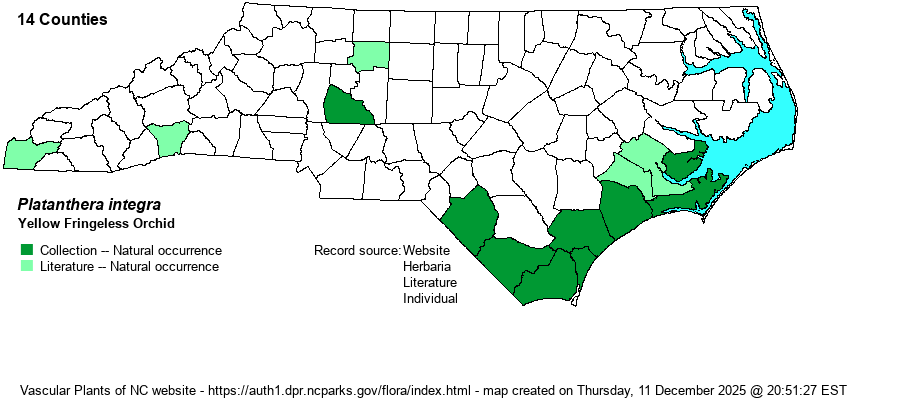| Author | (Nuttall) A. Gray ex Beck | |
| Distribution | Found only (currently) in the southern Coastal Plain, from Croatan National Forest (Craven County) south mainly in coastal counties to the SC state line. Documentation from the Piedmont and Mountain counties is surprisingly poor, and the records are 50-100 years or more old. The Rowan County specimen was taken from "Dunn's Mountain" in August 1894 by J.K. Small.
This is primarily a species of the Atlantic and Gulf Coastal Plains, ranging north (as disjunct) to NJ and south to central FL. It ranges west to extreme eastern TX. There are a few records for central TN (Manchester Barrens, an area famous for disjuncts), thus giving reason to believe that the historical records from inner NC were actually legitimate. It is not known from VA, MD, or DE. | |
| Abundance | Uncommon in well-managed (with fire) preserves in coastal counties, but otherwise very rare to rare in areas outside protected sites. Formerly extremely rare in the Piedmont and Mountains, but assumed to be extirpated now from these regions. This is a State Threatened species. The NCNHP moved the State Rank from S2 to S1 in late 2022. | |
| Habitat | This species is essentially limited in the state to savannas, growing under scattered Longleaf Pines (Pinus palustris), or in nearby powerline clearings that mimic savannas. In both cases, the sites must be frequently burned (every several years) to keep woody species at bay. In the Piedmont and mountains, it grew in bogs. |
| Phenology | Blooms from July into early September, somewhat later than similar golden or orange flowering species -- P. ciliaris and P. cristata, though all three could be seen in bloom on the same date. Fruits shortly after flowering. | |
| Identification | This is an attractive orchid in bloom, though is one of the smaller of the savanna orchid species. It grows mostly just to 1-1.5 feet tall. The flower cluster is densely packed with small golden-yellow flowers, each only about 1/3-inch across, with a small spur; the cluster averages just 2-3 inches high. What separates this species from the similar P. cristata is that P. integra has a lip that is elongated but is only wavy-margined, as opposed to strongly fringed in P. cristata. This latter species has flowers tending to be more orange in color, usually noticeable in the field, though to be sure you will need to examine the plants within a few feet to check out the fringing amount on the lips. As with other Platanthera species, it has a few stem leaves, not at all helpful in species identification. Though it is the least numerous of the three yellow to orange fringed orchids, it can grow in colonies of a few dozen individuals in sites where properly managed by fire. However, it does poorly away from managed areas, whereas the other two can grow along grassy roadsides and in less heavily managed sites. | |
| Taxonomic Comments | None, other than formerly known as Habenaria integra.
| |
| Other Common Name(s) | Golden Fringeless Orchid | |
| State Rank | S1 [S1S2] | |
| Global Rank | G3G4 | |
| State Status | T | |
| US Status | | |
| USACE-agcp | OBL link |
| USACE-emp | OBL link |

